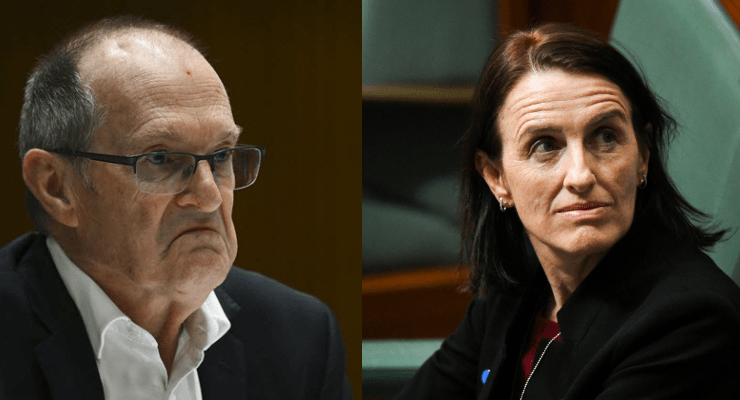
It’s a measure of how worried Scott Morrison is about the fallout from the mistreatment by his government of Brittany Higgins that in the space of five days — after his disastrous “I checked with Jen” response — the prime minister announced not one, not two, not three, but four inquiries and reviews.
The first two — announced last week in an effort to put the Higgins revelations into a political siding — are one by Prime Minister and Cabinet (PM&C) deputy secretary Stephanie Foster examining the processes in place for supporting people who come forward with complaints in the future. The second is an internal Coalition review by Liberal MP Celia Hammond looking at staffing issues.
A third — called in a panic when Morrison’s story that his office knew nothing of what happened to Higgins began to fall apart — is being conducted by PM&C head Phil Gaetjens to find out who inside the PM’s office knew about the alleged rape. It’s confined to the Prime Minister’s Office (PMO) and it’s not clear it will ever be made public.
A fourth, future, review will look into workplace culture of parliamentarians and their staff, after Senate leader and Special Minister of State Simon Birmingham has consulted with other parties about terms of reference.
None address the core issues raised by Higgins who this week will speak to the Australian Federal Police to investigate her sexual assault in the offices of Linda Reynolds in March 2019.
In fact the panoply of inquiries seem designed to address everything but the serious questions raised by what happened to her and how it was handled: why so many parties knew about her assault and knew more details about her assault than she did; what the circumstances were of the departure of her alleged rapist and what bona fides were given to his future employers — a crucial issue given he is now accused of being a serial rapist; why there are so many flaws and inconsistencies in the account provided in the aftermath of the alleged assault by Morrison, Reynolds and others, such as Morrison’s assurance that the PMO knew nothing of what happened until two years later, or Reynolds’ insistence she was unaware Higgins had been raped.
And most of all, why did Higgins feel that she faced a choice of reporting the rape to police or keeping her job?
This is not merely a political issue of what Morrison knew and when, or whether he had a de facto policy of “don’t ask don’t tell” about such matters, or of the deeply toxic workplace culture over which Morrison (despite Nine newspapers’ efforts to portray him as separate from and above it) presided, but of whether a woman was discouraged from reporting a serious crime with an implied threat to her employment.
None of the slew of inquiries and reviews will go close to addressing these issues.
The Gaetjens inquiry is confined strictly to whether there is evidence individuals in the prime minister’s office knew about the rape — something already established by text messages and the employment there of Reynolds’ former chief of staff.
In any event, after his laughable sports rorts “inquiry” Gaetjens has little credibility when it comes to investigating a Coalition government.
For that matter the other three inquiries offer little of substance. The context for the internal Coalition review by right-wing MP Celia Hammond is that the government has been aware for a long time of a culture of bullying and misogyny within the Coalition and the sexual predation on staffers by senior ministers. These things are a matter of public record, and nothing has been done.
The review by Foster is entirely about internal systems for dealing with complaints by staffers, which fails — deliberately — to recognise that fixing an internal process will do nothing if, as has been the case with the PMO’s response to what Higgins revealed, the political imperative from the PMO down is to downplay, cover up and distract from such complaints as much as possible.
As for the review Birmingham is discussing terms of reference on with other parties on political workplaces, those workplaces are the creation of the parties themselves and reflect the needs and wishes of the parties. Asking politicians to review their own workplaces is nonsensical.
Only an external, independent inquiry — with powers to access parliamentary records and communications between staffers and politicians, and question everyone from the PM down — can properly examine how the government so badly mishandled the rape of a young woman in its own ministerial offices.
If you or someone you know is affected by sexual assault or violence, call 1800RESPECT on 1800 737 732 or visit 1800RESPECT.org.au.









Whatever Morrison is doing, it seems to be working since his approval ratings have gone up. What does that say about our society.
You get that creepy feeling that you’re surrounded by people who thinks this behaviour is all OK, probably because everyone does it?
Its starting to really makes me feel uncomfortable to live among my fellow australians who give a rats bum about these issues or are so ignorant they still think he’s a good PM. This is not some complex policy issue.
Like a lot of other issues that arise during his tenure as PM, he starts by denying, or deflecting, then calling Inquiries, (with intended outcomes probably already determined. Anything to ensure that the issue is “kicked down the road”, and the media will move on. Everything to ensure that no blame rubs off on him
He can always count on Murdoch crap rags and Costello’s channel nine to cover up for him by only reporting what he’s done but miss out how long it took him to get the idea of four reviews but none tp do with that young lady’s shattering experience. So glad she has found her voice, pity the party hacks prefer coverups in place of investigating the truth.
Morrison can’t do complex policy or just about anything else that he can duck/ shove to someone else.
Lazy is too kind a descriptor for the Kirrabilli House squatter.
This is what happens when the selection process is done on what Clive Palmer and Gina darling want.
Clive swung the federal government election with his bogus “death tax” advertising blitz.
The Queensland Labor Party fixed that by calling him a liar, highlighting the uses of “Might, may, maybe, possibly” with a big red circle around the hedge words.
The vote for Palmer’s party evaporated.
This is what happens when the truth is easily discernible once it is highlighted.
Clive will need to find his credibility.
Parliamentary staffer of well over a decade here. What will inevitably be missing from all of these reviews, just as it missing from the reporting, commentary and bloviating coming from the press gallery, is journalists’ complicity in the “toxic” culture of parliament house. The Sydney Morning Herald in an editorial last week thundered that it is “past time to confront Canberra’s toxic culture”. Indeed it is. That’s why the Sydney Morning Herald’s editorial management (along with Nine’s other mastheads) should direct their gallery journos to get some real friends in Canberra or go home to their wives. That way, they’re not hanging around at Public bar in Maunuka on Wednesday nights in sitting weeks cracking on to young staffers. Gallery journos have power over young media advisers and other staffers. A journalist’s decision to run or not run a story worked up by a media advisor, or to accept or not accept a drop can be a make-or-break moment in a young advisor’s career. While the press galley will be reluctant to accept any responsibility for the culture of the place, they should. Too many gallery journalists fancy themselves as players in the political game to be considered bystanders in the culture they now so loudly want to declaim. My advice to them: go home to your wives, girlfriends and families on sitting week Wednesdays. If they don’t want you, try to make some friends outside politics. If that doesn’t work, get a dog.
Interesting insights, and indeed many of the gallery journos are political players rather than reporters, and not just News Corpse journos.
Perhaps this whole type of ‘access journalism’ should be banned once and for all. Already you get better analysis from journo’s not in the gallery. If MP’s or staff want to drop a story, they will know how to find a trusted journo. Removes conflict of interest as well with journo’s self censoring because of access.
Nice double reverse farnarkle with twist.
I’m sure Gaetjens is already hard at work with Sir Humphrey’s playbook, with the (probably foregone) conclusion’s path being designed to satisfy Slomo, but not voters who want accountability but only get snowjobs from this shower.
I would suggest the “damage control” department in the PM’s office would be burning the midnight oil and far no less than 4 enquires are the result.
He is a lovable, kind-hearted man, almost a saint, really.
“Firewalls ‘R Us” – Children Overboard, all over again.
“We will decide what are the relevant facts and the circumstances in which they come out.”
And again, it’s not just Nein News that’s trying to pull Scotty’s chestnuts from the fire, Fanning (The Dum) last Wednesday was quite happy to tell us that he’d “made it clear” that he knew nothing – case closed – despite his track record, in the mud.
Relying on recent statements by three young women, it would appear that a serial rapist has been operating in a Liberal party parliamentary ecosphere for several years. These reports reminded me of an article in The Atlantic published in 2019 (‘An Epidemic of disbelief: what new research reveals about sexual predators’). A random police search of a Cleveland warehouse containing material from police investigations revealed thousands of cardboard boxes and plastic bags containing rape tests; the officer discovered that the overwhelming number of them had ever been opened or tested.
Through his efforts and those of another dedicated law enforcement officer, money was found to conduct many more tests. ‘Of the rape kits containing DNA that generated a CODIS hit, nearly one in five pointed to a serial rapist—giving the Cleveland investigators leads on some 480 serial predators to date. On a practical level, this suggested that every allegation of rape should be investigated as if it might have been committed by a repeat offender.’
An example: ‘Here’s the evidence box from a deaf woman Wilkes assaulted in June 2006. There’s one from a woman he raped in May 2007. The kit from his sixth victim arrived in June 2010. Another a month later. Two more in August 2011. His 10th victim, four months after that. Not until he raped his 11th victim, in January 2012, did the sequence end, because that woman saw Eric Wilkes two days after the assault and called the police, who arrested him. Eleven years, 11 violent rapes—all while Wilkes’s identity was preserved in sealed containers that no one had bothered to open.
The results have upended assumptions about sexual predators—showing, for example, that serial rapists are far more common than many experts had previously believed.’
Here’s the link to the article: https://www.theatlantic.com/magazine/archive/2019/08/an-epidemic-of-disbelief/592807/